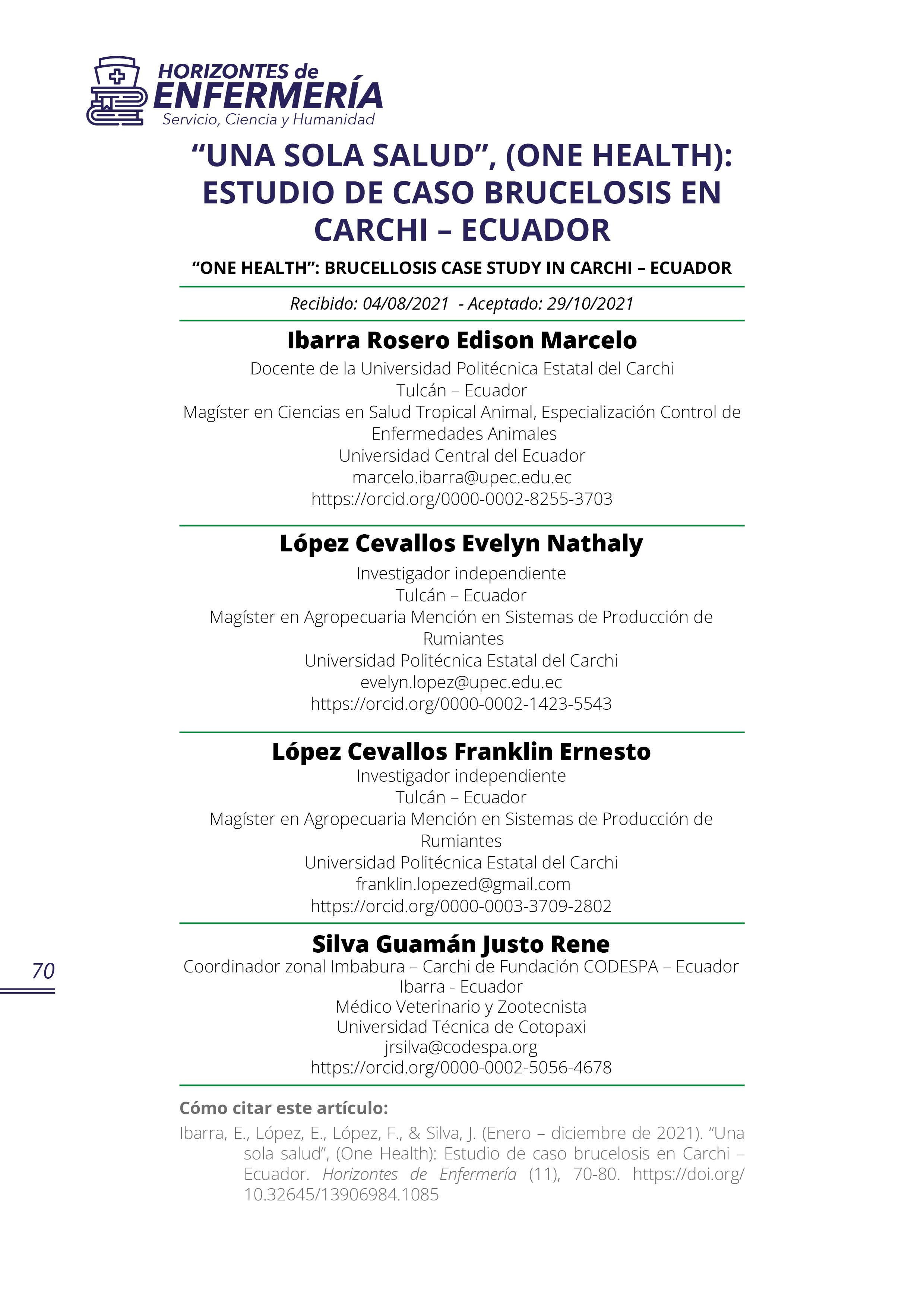“One health”: Brucellosis case study in Carchi – Ecuador
DOI:
https://doi.org/10.32645/13906984.1085Keywords:
One health, brucellosis, CarchiAbstract
In order to establish the relationship between bovine brucellosis, human brucellosis and the risk factors, under the scheme of “one health”, a study was carried out in 10 Agricultural Productive Units (APUs) in the province of Carchi, where 50 people and 450 cattle were interceded. To identify the risk factors, a questionnaire was developed and applied through an interview. The animal diagnosis was made using Polarized Fluorescence tests in milk, Rose Bengal in blood
serum, and positive samples confirmed by competitive ELISA, using the same diagnostic scheme for human brucellosis in blood serum. The relationship between bovine brucellosis and human brucellosis was determined using the Kappa index. Epidemiological case-control studies
identified the associated risk factors through Odds ratios. The results show 5 APUs diagnosed as positive for bovine brucellosis, of which three were diagnosed positive for human brucellosis. The concordance analysis between bovine and human brucellosis shows a Kappa index of 0.6 (0.104 - 1.096 95% CI), denoting a moderate qualitative concordance. The following risk factors were identified for human brucellosis: the consumption of raw or unpasteurized milk, the absence of personal protective equipment (PPE), accidents with used sharp-pointed materials, the presence of different animal species, and the presence of positive reactive animals, whereas,
the exclusive use of a site designed for births, and the suitable elimination of biological waste constituted protection factors.
References
Acosta, A. (2017). Prevalencia de brucelosis (brucella abortus) en vacas en producción lechera
en el cantón Espejo. Doctoral dissertation. Pontificia Universidad Católica del Ecuador
Sede Ibarra. Recuperado el 22 de julio del 2021 de http://dspace.pucesi.edu.ec/bitstream/11010/200/1/1%20TESIS.pdf
Annual report on human brucellosis in Tiaret, 2002. Tiaret, Algeria, Directorate of Public Health, 2002.
Aggad, H., & Boukraa, L. (2006). Prevalence of bovine and human brucellosis in western Algeria: comparison of screening tests. EMHJ-Eastern Mediterranean Health Journal, 12 (1-2),
-128, 2006.
AGROCALIDAD, (2009). Sanidad Animal, control zoosanitario. Recuperado el 15 de junio del
de https://www.agrocalidad.gob.ec/wp-content/uploads/pdf/sanidad-animal/02-
control-zoosanitario/Resolución%20025.pdf
Bamaiyi, P. (2016). Prevalence and risk factors of brucellosis in man and domestic animals: A review. Recuperado el 16 de julio del 2021 de https://www.onehealthjournal.org/Vol.2/6.pdf
Bragazzi, N. L. (2020). One health approach to tackle brucellosis: a systematic review. Tropical
medicine and health, 48, 86. https://doi.org/10.1186/s41182-020-00272-1
Cárdenas, Z. (2018). La Brucelosis Bovina y sus factores de riesgo: Evaluación a nivel mundial y en Colombia. Tesis Doctoral. Universidad Autónoma de Barcelona.
Fernández, D. E. (2001). Tipos de estudios clínicos epidemiológicos. Recuperado el 21 de julio del 2021 de https://www.fisterra.com/mbe/investiga/6tipos_estudios/6tipos_estudios2.pdf
Gómez, M., Sepúlveda, C., Ibrahim, M., y García, C. (2018). Identificación, priorización y análisis
costo-beneficio de buenas prácticas ganaderas que los productores de fincas estratificadas
implementan para reducir los efectos de la variabilidad climática en el municipio de Olanchito, Yoro, Honduras. Producción Agropecuaria y Desarrollo Sostenible, 7, 73-97.
González, P. (2018). Factores de riesgo asociados a la brucelosis bovina (Brucella abortus) en
vacas en producción lechera en el cantón Montúfar. Universidad Politécnica Estatal del Carchi. Recuperado el 22 de julio del 2021 de http://repositorio.upec.edu.ec/bitstream/123456789/603/1/INFORME%20DE%20INVESTIGACIÓN%20POLIVIO%20GONZÁLEZ%20.pdf
Landis J, Koch G., (1977), The measurement of observer agreement for categorical data. Biometrics. 33, 159-74.
López de Ullibarri I, Pita S., (1999), Medidas de concordancia: el coeficiente kappa. Cad aten
primaria. 6, 169- 71. Disponible en www.fisterra.com
Organización Internacional de Sanidad Animal (OIE). (2021). Brucelosis. Recuperado del 20 de
junio del 2021 de https://www.oie.int/es/enfermedad/brucelosis/.
Organización Mundial de Salud (OMS). (2020). Brucelosis. Recuperado el 20 de junio del 2021 de https://www.who.int/es/news-room/fact-sheets/detail/brucellosis
Ortego, M. (2014). Brucelosis: Enfermedad Profesional. Trabajo de Fin de Grado. Universidad de Valladolid.
Ogata, R., et al. 2009. Epidemiological situation of bovine brucellosis in the State of Tocantins,
Brazil. Arquivo Brasileiro de Medicina Veterinária e Zootecnia. 61 (1): 126-34.
Ron, J. (2014). Human Brucelosis in Northwest Ecuador: Typifying Brucella spp., Seroprevalence and Associated Risk Factors. Vector-Borne and Zoonotic Diseases.
Ron, L. (2013). Spatio-temporal clusters of incident human brucellosis cases in Ecuador. Spatial and Spatio-temporal Epidemiology.
Roth, F., Zinsstag, J., Orkhon, D., Chimed-Ochir, G.,Hutton, G., Cosivi O., Carrin, G. and Otte, J.
(2003). – Human health benefits from livestock vaccination for brucellosis.Case study. Bull.
WHO, 81: 867-876
Sapbamrer, R., & Thammachai, A. (2020). Factors affecting use of personal protective equipment and pesticide safety practices: A systematic review. Environmental research, 185, 109444.
Tibesso, G., Ibrahim, N., & Tolosa, T. (2014). Sero prevalence of bovine and human brucellosis in Adami Tulu, Central Ethiopia. World Appl Sci J, 31(5), 776-80.
Zunino, P. (2018). Historia y perspectivas del enfoque “Una Salud”. Veterinaria (Montevideo), 54

Downloads
Published
Issue
Section
License
Copyright (c) 2021 Edison Marcelo Ibarra Rosero , Evelyn Nathaly López Cevallos, Franklin Ernesto López Cevallos , Justo Rene Silva Guamán

This work is licensed under a Creative Commons Attribution-NonCommercial-ShareAlike 4.0 International License.
El autor mantiene los derechos morales e intelectuales de su obra, autorizando a la editoruial de la revista revista Horizontes de Enfermería ladifusión y la divulgación de su contenido con fines estrictamente académicos y de investigación, sin fines de lucro.





